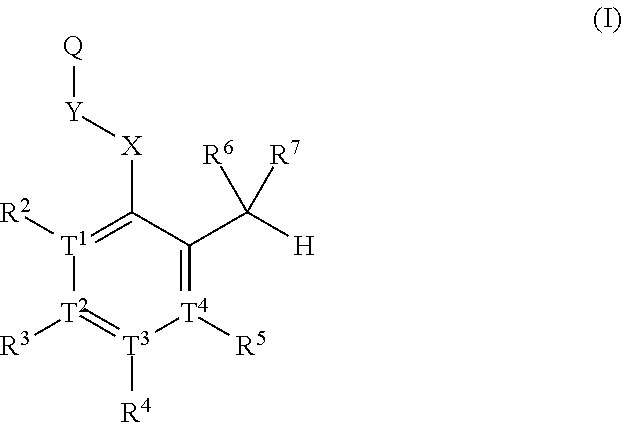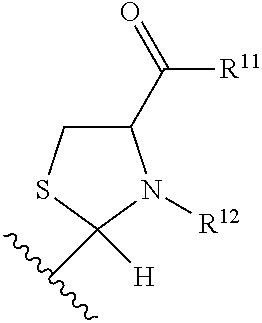Substituted aldehyde compounds and methods for their use in increasing tissue oxygenation
a technology of substituting aldehydes and compounds, which is applied in the field of substituting benzaldehydes and heteroarylaldehydes and derivatives, can solve the problems of unfulfilled elucidation of their allosteric regulation and blockage of blood vessels, and achieve the effect of increasing tissue oxygenation and oxygenation
- Summary
- Abstract
- Description
- Claims
- Application Information
AI Technical Summary
Benefits of technology
Problems solved by technology
Method used
Image
Examples
example 1
Preparation of cis-methyl 4-((2-formyl-3-hydroxyphenoxy)methyl)cyclohexanecarboxylate (Compound 1)
Step 1.
[0222]
[0223]To a mixture of 2,6-dihydroxybenzaldehyde (100 mg, 0.73 mmol, 1 eq.) and CH(OEt)3 in EtOH (10.0 mL) were added ethane-1,2-diol (225 mg, 3.62 mmol, 5.0 eq.) and tetrabutylammonium tribromide (TBATB, 3.5 mg, 0.007 mmol, 0.01 eq.). The mixture was stirred at rt for 2 h, diluted with EtOAc (20 mL), washed with water and brine, dried over Na2SO4, concentrated, and purified on silica gel using a mixture of EtOAc and hexanes as eluent to give 2-(1,3-dioxolan-2-yl)benzene-1,3-diol (40 mg, 30%) as a yellow solid. 1H NMR (400 MHz, CDCl3) δ 7.96 (s, 2H), 7.07 (t, J=8.2 Hz, 2H), 6.41 (d, J=8.2 Hz, 2H), 6.01 (s, 2H), 3.76-3.66 (m, 4H).
Step 2.
[0224]
[0225]To a mixture of 2-(1,3-dioxolan-2-yl)benzene-1,3-diol (40 mg, 0.22 mmol, 1 eq.), cis-methyl 4-(hydroxymethyl)cyclohexanecarboxylate (45 mg, 0.26 mmol, 1.2 eq.), and PPh3 (86 mg, 0.33 mmol, 1.5 eq.) in THF (0.5 mL) was added DIAD (...
example 2
Preparation of cis-4-((2-formyl-3-hydroxyphenoxy)methyl)cyclohexanecarboxylic acid (Compound 2)
[0226]
[0227]To cis-methyl 4-((2-formyl-3-hydroxyphenoxy)methyl)cyclohexanecarboxylate (13 mg, 0.045 mmol, 1 eq.) in MeOH (3.0 mL) was added NaOH (3 N, 1 mL, 4.6 mmol). The mixture was stirred at rt for 2 h, acidified to pH 3, and filtered. The filtrate was purified by RP-HPLC (Gemini 21.2×150 mm) using a mixture of CH3CN and water as eluent to give cis-4-((2-formyl-3-hydroxyphenoxy)methyl)cyclohexanecarboxylic acid (6.0 mg, 49%) as a colorless oil. 1H NMR (400 MHz, CDCl3) δ 12.14 (s, 1H), 10.57 (s, 1H), 7.59 (t, J=8.4 Hz, 1H), 6.71 (d, J=8.5 Hz, 1H), 6.55 (d, J=8.4 Hz, 1H), 4.10 (d, J=6.6 Hz, 2H), 2.92 (quin, J=4.5 Hz, 1H), 2.37-2.27 (m, 2H), 2.24-2.14 (m, 1H), 2.03-1.92 (m, 2H), 1.92-1.80 (m, 2H), 1.74-1.60 (m, 2H). LRMS (M−H+) m / z 277.1.
[0228]The compounds in Examples 3-7 were prepared according to the procedure described in Examples 1 and 2.
example 3
Preparation of (1R,3S)-3-((2-formyl-3-hydroxyphenoxy)methyl)cyclohexanecarboxylic acid (Compound 3)
[0229]1H NMR (400 MHz, CDCl3) δ 11.95 (s, 1H), 10.39 (s, 1H), 7.40 (t, J=8.4 Hz, 1H), 6.53 (d, J=8.4 Hz, 1H), 6.36 (d, J=8.3 Hz, 1H), 3.95-3.83 (m, 2H), 3.70 (s, 3H), 2.49-2.32 (m, 1H), 2.16 (d, J=12.9 Hz, 1H), 2.10-2.01 (m, 1H), 2.01-1.82 (m, 3H), 1.48-1.22 (m, 3H), 1.22-0.99 (m, 1H).
PUM
| Property | Measurement | Unit |
|---|---|---|
| temperature | aaaaa | aaaaa |
| temperature | aaaaa | aaaaa |
| temperature | aaaaa | aaaaa |
Abstract
Description
Claims
Application Information
 Login to View More
Login to View More - R&D
- Intellectual Property
- Life Sciences
- Materials
- Tech Scout
- Unparalleled Data Quality
- Higher Quality Content
- 60% Fewer Hallucinations
Browse by: Latest US Patents, China's latest patents, Technical Efficacy Thesaurus, Application Domain, Technology Topic, Popular Technical Reports.
© 2025 PatSnap. All rights reserved.Legal|Privacy policy|Modern Slavery Act Transparency Statement|Sitemap|About US| Contact US: help@patsnap.com



